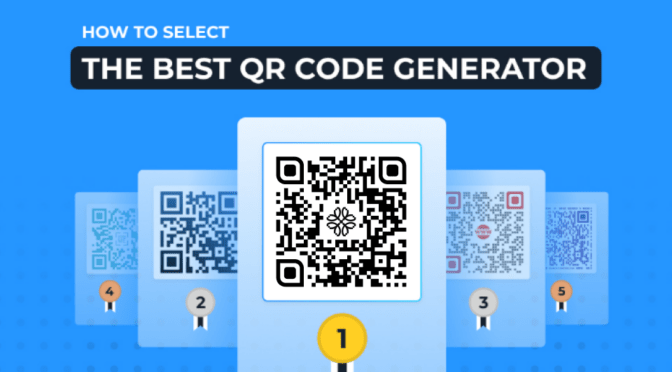💻 Key takeaways:
1. While a QR Code itself may be permanent, the concept of a truly “permanent” code hinges on the content it directs users to. Static QR Codes, once generated, cannot be edited, leading to broken links if the content changes.
2. Dynamic QR Codes provide true permanence by allowing you to update the destination URL even after deployment. This ensures users always reach the intended content, regardless of future changes.
3. When using dynamic QR Codes, prioritize clear and concise information as the call to action. This context helps users understand the QR Code’s purpose and boosts scan rates and interaction.
Is a QR Code permanent or temporary? Can I have a permanent QR Code? Which QR Codes do not expire?
There is a lot of skepticism regarding the permanence and impermanence of QR Codes.
The question of a QR Code being temporary or permanent arises because there are two types of QR Code in the market:
- Static QR Codes, which are called permanent, as they do not expire. But you cannot edit the content that the QR Code leads to
- Dynamic QR Codes, which are actually permanent as they are editable, and you can use them in the long term
Most people attach the inability to change the content in static QR Codes with permanence.
But is it so? Are static QR Codes permanent just because they do not expire? And dynamic impermanent?
In this article, we clarify what a permanent QR Code is and the checklist to create one.
Read on to find out how to use permanent QR Codes in the long term for your use case.
Table of contents
- What is a permanent QR Code?
- Why static QR Codes fall short of being a permanent solution?
- How do I know if the QR Code I generated is permanent?
- Choosing the right permanent QR Code generator: a simple checklist
- Frequently asked questions
What is a permanent QR Code?

A permanent QR Code is a QR Code that always leads to the intended information, even if the content/URL changes over time.
Imagine someone scanning your QR Code only to find a 404 error page. Or the content embedded is outdated. It would not make much sense even if the QR Code itself is intact.
In other words, a QR Code is considered permanent if it’s scannable and does not show a 404 error to the end-user when they scan it.
Hence, the permanence or impermanence of a QR Code does not solely depend on the QR Code itself (unless it is blurry or damaged) but also on the content embedded in it.
Why do static QR Codes fall short of being a permanent solution?

Free, static QR Codes may seem like a good choice for a one-time use case. But they fall short if you aim for the long-term success of your QR Code campaigns.
This is because static QR Codes are non-editable, meaning that you must create a new QR Code for any content modifications.
If you need to make frequent changes or updates, dynamic QR Codes offer the flexibility to edit the content and track QR Code scans, making them a more permanent and effective solution for long-term QR Code campaigns.
How do I know if I’ve generated a QR Code that doesn’t expire?
You must consider two factors to determine if your QR Code is permanent: scannability and accessibility.
1. Scannability
Ensure your QR Code is scannable, meaning a mobile device camera can easily read it.
If the QR Code becomes damaged or distorted, it may lose its scannability and will no longer be considered permanent.

2. Accessibility
Ensure that the website, files, or URL the QR Code leads to is accessible and does not show a 404 error.
If the website or URL becomes unavailable, the QR Code will no longer redirect scanners to the intended destination, becoming inaccessible.

To ensure that your QR Codes meet these two criteria, it’s best to use dynamic QR Codes.
Dynamic QR Codes ensure permanence as they have inbuilt error correction to remain scannable and accessible to the content it leads to.
You can edit your QR Codes to ensure it always leads to the intended destination at all times—making it permanent.
Choosing the right permanent QR Code generator: a simple checklist

By now, you must be clear that the scannability and accessibility of QR Codes determine their permanence and long-term success.
That’s where dynamic QR Codes enter. They offer several flexibility and benefits over static QR Codes—making them a permanent solution in the long run:
Before you zero in on your QR Code generator, it is essential to analyze a few pointers as follows:
| ✅Checklist | Why |
| ♾️Dynamic QR Codes | Dynamic QR Codes are editable. It means they’re more likely to remain scannable because you can quickly replace 404 errors and update or modify the content. |
| ✏️Customizability | You can personalize the appearance of your QR Codes, such as selecting colors and adding a logo or image to the QR Code. |
| 🔧Option to resize | Resizing allows you to modify the size of QR Code for different marketing materials and surfaces, ensuring scannability. |
| 🧑💼Custom-domain | Custom domain allows using branded URL instead of a generic one, which increases trust and recognition among the audience. |
| ⚙️Analytics | Ensure that the QR Code platform provides detailed QR Code analytics and reporting, including scan numbers, times, locations, and devices used. |
| ❗Error Correction | The error correction level of a QR Code determines its ability to remain readable despite damage. |
| 🔐Enterprise-grade security | SOC® 2 and GDPR security measures ensure that the platform has undergone auditing procedures to manage data safely and securely. |
| 💻Integrations | Integrations allow you to extend your workflows into other systems, making it easy to integrate your QR Code campaigns with other tools and platforms, such as Google Analytics, HubSpot, and Salesforce. |
| 🚀Multi-format support | The QR Code platform should enable you to link your QR Codes to various types of content such as website, videos, documents, etc. and accommodate different use cases including print and digital platforms. |
Obtain long-term benefits from your QR Code campaigns with permanent QR Codes
The permanence of a QR Code depends on its type and usage. Static QR Codes are called permanent in terms of where they redirect the audience to, but fall short in terms of flexibility and tracking.
Dynamic QR Codes, on the other hand, offer more flexibility and permanence regarding their usage.
Uniqode’s QR Code generator offers a reliable solution, delivering permanent and high-performing QR Codes for sharing website URLs, contact information, and promotional messages.
With advanced features and analytics, Uniqode enables you to track performance and make informed decisions based on data.
Wondering how you do that? Get started below 👇

Frequently asked questions
1. How do I permanently create a QR Code?
You can make a permanent QR Code using Uniqode QR Code generator by following these steps:
- Log-in to the Uniqode dashboard and select dynamic QR Codes.
- Select the QR Code campaign type.
- Input required information such as your website URL.
- Customize your QR Code color, shape, logo, etc., according to your brand identity.
- Select download to generate your permanent QR Code.
2. How long do QR Codes last?
No, dynamic QR Codes do not have an expiration date. They are editable, and hence you can replace any expired content that it leads to. They also have error correction built in, which ensures scannability at all times.
3. Will my QR Code expire?
You can ensure that your QR Code doesnt expire, by creating a dynamic QR Code. You can always edit, or modify the content behind it to have it scannable at all times.
4. How do I make my QR Code last forever?
To make a QR Code last forever, you can create dynamic QR Codes using a QR Code generator such as Uniqode. Dynamic QR Codes are permanent codes that allow you to edit and modify information such as website URL, contact information, or a promotional message according to your campaign strategy. Using dynamic QR Codes also saves you time and reprinting costs in the long run.
Ektha is a QR code expert with years of research and analysis into the evolution of QR codes. Having written over 70 in-depth articles on QR technology, she has developed a comprehensive understanding of how QR codes are transforming industries. Her insights, including The State of QR Report, have been featured in leading publications. With a passion for simplifying complex topics and providing actionable strategies, Ektha helps businesses leverage QR codes to enhance their ‘phygital’ connections.











